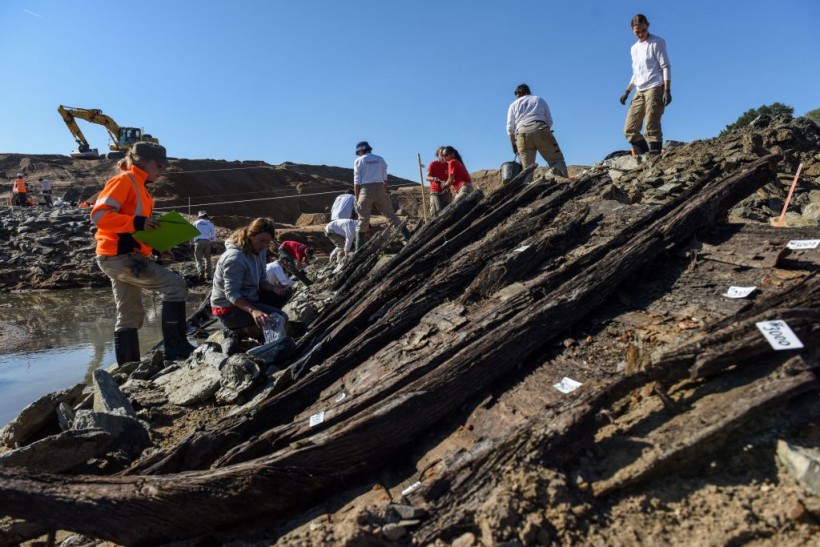Material scientists have solved the enigma of a 17th-century Dutch warship that was lost off the coast of England while transporting slabs of beautiful Italian marble. The Dutch vessel Klein Hollandia has been confirmed as the mysterious shipwreck off the coast of Eastbourne.
As per MailOnline, the ship is said to have been built in 1656 and held by the Admiralty of Rotterdam. It was involved in every significant combat during the second Anglo-Dutch war (1665-1667). Currently, the shipwreck sits 105 feet (32 meters) beneath the seabed.

Archaeologists of the French National Institute for Preventive Archaeological Research(INRAP) work on the remains of at least nine shipwrecks of the 17th-18th century on a bank of the River Loire, at Oree dAnjou, western France, on September 21, 2022.
The Unknown Wreck Off Eastbourne Finally Identified
The newly-identified shipwreck off the coast of England is said to be the Dutch battleship Klein Hollandia. A large portion of the wooden hull was discovered, together with cannons, Italian marble tiles, and bits of Italian ceramics. Eastbourne diving operator David Ronnan spotted the wreck and reported it to Historic England.
The Klein Hollandia was deemed so valuable that it received the highest level of protection under the Protection of Wrecks Act 1973, which meant that only licensed divers were permitted to dive into the wreck site.
BBC News reported that the marble tiles discovered on the site were sourced from quarries in the Apuan Alps near Carrara, Italy, and were maintained by Historic England archaeological conservators. The tiles were destined for the Netherlands and would have been used to construct high-status dwellings.
Heritage Minister Lord Parkinson of Whitley Bay said that the identification of the Klein Hollandia gives information about the 17th century, which gives more opportunity to learn more about the ship's unearthed treasures, as well as how 17th-century Dutch ships were built and learn of its final voyage.
The ship was part of the squadron that escorted the Smyrna fleet from the Mediterranean into the English Channel en route to the Netherlands in 1672. The squadron was assaulted by an English squadron headed by Admiral Holmes as it passed the Isle of Wight, causing the Klein Hollandia to be damaged and its captain to be slain. READ ALSO: Mayan Slave Ship From the Caste War Discovered in Mexico
Material Scientists Help Confirming the Ship's Identity
Historic England's chief executive Duncan Wilson said that England's material scientists have played a significant role in unraveling the mystery of the Unknown Wreck Off Eastbourne and so disclosed its identity to the public. They collaborated with the Netherlands Cultural Heritage Agency and the Nautical Archaeology Society to authenticate its identity, which has the highest degree of protection.
In a press release, the organization wrote that the ship's condition is described as "extraordinary," and Historic England hopes it will provide a wealth of knowledge on how 17th-century Dutch ships were built as well as the warship's activities during its final journey.
Much of the timber hull, cannon, Italian marble tiles, and bits of Italian ceramics were discovered on the seafloor. Scientists employed petrographic investigation or the use of microscopes to analyze rock, mineral composition, and isotope analysis and identified the stone as marble from the Apuan Alps quarry, which produces some of the best marble in Italy.
Nautical Archaeology Society chief executive Beattle-Edwards said that they have been enthralled by the diversity of material of the shipwreck upon discovering it in 2019. Its materials indicate that they belong to a late 17th-century Dutch ship returning from Italy.
RELATED ARTICLE: 17th Century Dutch Cargo Vessel Found in the Baltic Sea
Check out more news and information on Archaeology in Science Times.














